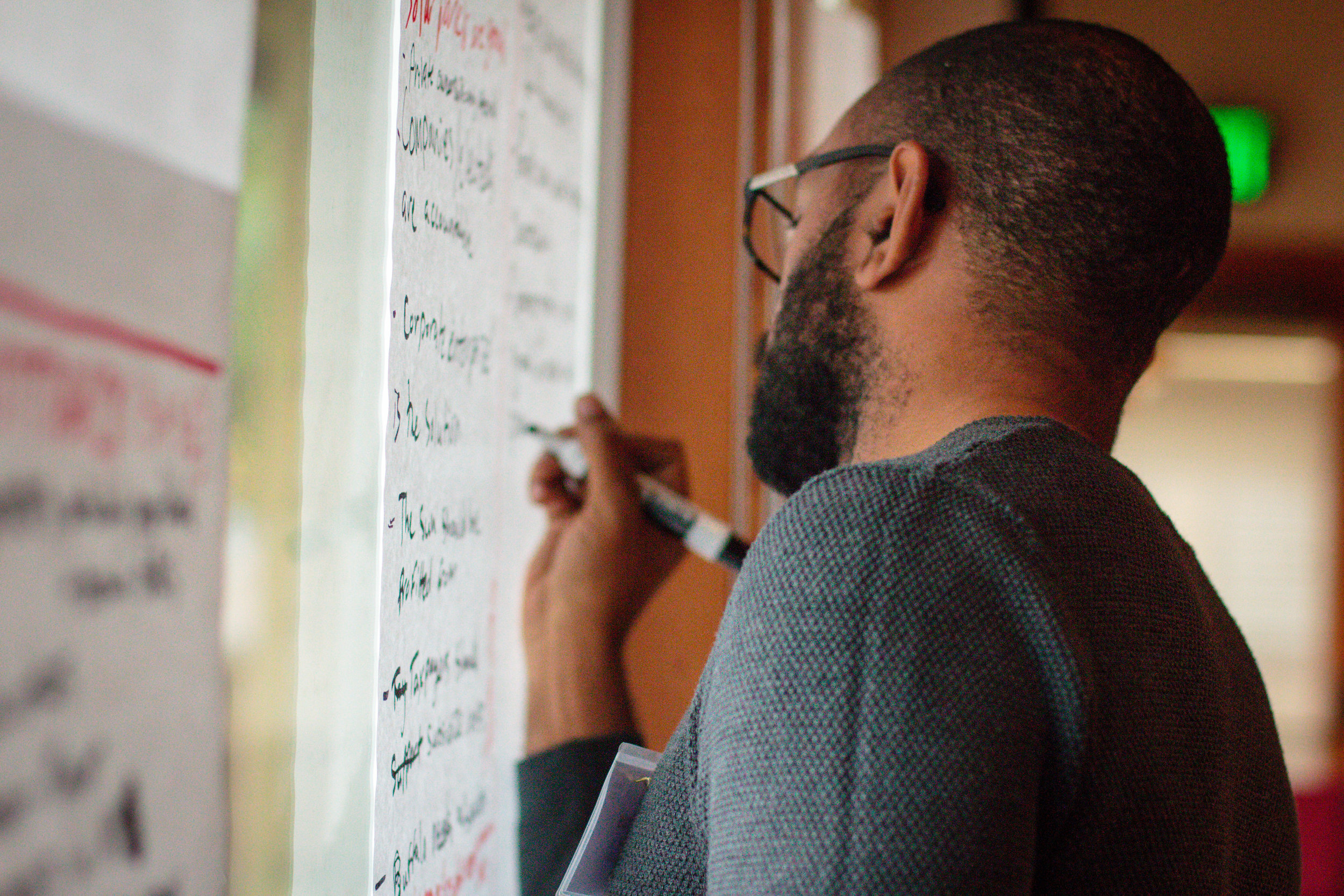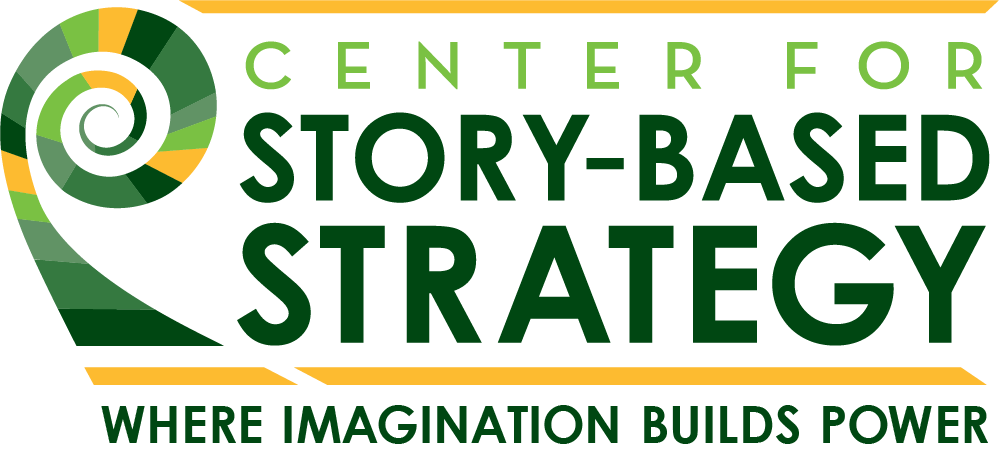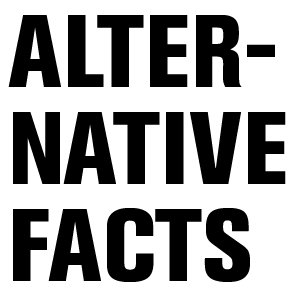
What is story-based strategy?
Story-based strategy is a participatory approach that links movement building with an analysis of narrative power and places storytelling at the center of social change.
Every practitioner defines it in their own way.
Elements of Story
We use five Elements of Story to analyze our opposition’s stories and to craft our own.
Using these elements of story, both for analysis and for generative work, story-based strategy proceeds through 4 main stages.
Break Down
the Power
Start by getting specific about goals, audiences, targets and constituencies to ensure that the stories and strategy we develop are grounded in the day-to-day realities of power around our issues. These are the Cornerstones of our work.
Battle of the Story!
Creating stories that challenge dominant narratives and control mythologies?
The Battle of the Story helps us craft stories that effectively intervene in the opposition's narrative, uplifting out own underlying assumptions around justice and liberation.
Their Story
Break down the opposition’s story into it’s component five elements of story. Understand the story you are aiming to change.
How does the story make existing outcomes possible or inevitable?
What do we have to believe, in order to believe their story is true?
Our Story
Our Story must challenge the opposition story’s underlying assumptions – taking care to avoid accidentally reinforcing them. It must uplift our underlying assumptions and reflect our values and the future we envision.
What assumptions can we uplift and claim that close the window on policies and outcomes we are against and open the window to outcomes we desire?
Put your audience in the front row
Who are the people that you need to reach and persuade?
Hint: the answer is never “the general public”.
- Imagine the audience(s) for your story as specifically as possible. Who are they? What kinds of jobs do they work? Education? What hopes, dreams, fears, and biases do they hold? What movies, shows, books and entertainment do they consume?
- See your work through the eyes of your audience. The meaning of words and images are determined NOT through your eyes, but through the eyes and hearts of your audience.
- Is your audience INSIDE our movements? Sometimes we take action to help move our movement organizations and communities on an issue. The questions above still apply.
Where will you intervene?
Story-based strategy informs more than just our messaging. A Point of Intervention is a place in a system – physical system or a system of ideas – where action can be taken to interfere with the story in order to change it. Our words and our actions combine to tell a story.
How will you intervene?
How do your actions and visuals take advantage of your chosen Point of Intervention to tell your story?
Now that you’ve picked a Point of Intervention, you need to develop the relationship between it and your story. Action Logic is the explicit or implicit narrative that is illustrated by a specific action; how an action makes sense politically to an outside observer.
Look for fissures. Fissures are cracks in the opposition story – Points of Intervention where the opposition’s story is particularly vulnerable, already in the process of changing, or extra-valuable as leverage.
Check your work
F.R.A.M.E.S. is a useful acronym representing 6 quick tests to use before moving a message from the drawing board out into the world. Use F.R.A.M.E.S. on your entire action/event plan, not just your top-level messaging.
Frame the Issue
Does it reinforce the vision and values that you are promoting? Framing means defining the problem, who will be broadly impacted, and the solution.
Reframe Opponent's Story & Reinforce Our Frame
Make sure your message is not just reiterating your opponent’s frame. Reframing means changing the terms of debate on the issue.
Accessible to the Audience
Who is your message trying to persuade? Be as specific as possible about the audience and ensure that the message is crafted in terms of language, context, and values that will be appealing to them.
Memorable
The message has got to be memorable, easy to spread and “sticky.” How can you encapsulate your message in a symbol, slogan, or metaphor that captures the essence?
Emotional
People don’t swing into action because of a pie chart. An effective message should speak to people in terms of values, and deliver some emotional impact. Trigger emotional responses with themes like tragedy, hope, anger, frustration, and don’t forget joy!
Simple & Short
This means to get to the core essence of the issue. What is the most important point of the issue? What is it that makes it matter to your audience?
#ChangeTheStory
Change the Story, because just telling a totally new story too-easily assumes people are empty vessels waiting for you to pour your story in. Pin down the story you need to change, and then take action to transform it.
So while this work is infused with imagination, it is grounded in your analysis, and your strategic assessment. Transforming the opposition stories takes time, but it’s essential to creating a world where the goals and futures you imagine are possible or inevitable.
Credit: NRDC.org
“If you tell me, it’s an essay. If you show me, it’s a story.”
#ShowDontTell
Show Don’t Tell, because unfortunately the facts often do not speak for themselves. Instead, we need to use images, metaphor, visualization and the five senses to illustrate what is important in the story as if we were painting a picture with our words. While the veracity of your claims is essential, facts only serve as the supporting details of the story, not the hook that makes the story compelling.
Take Story-based Strategy with you
Download the Story-based Strategy 101 PDF. This two-page document presents the information on this page, with added material, in a concise handout format you can use on your own project.
























